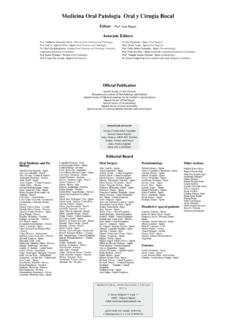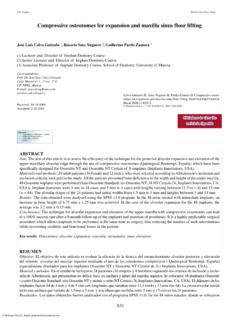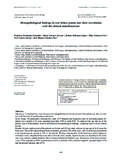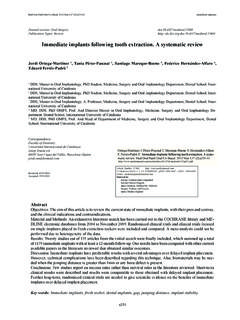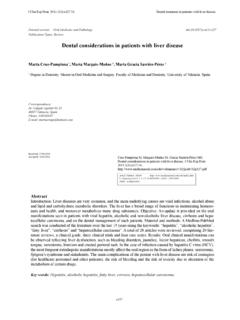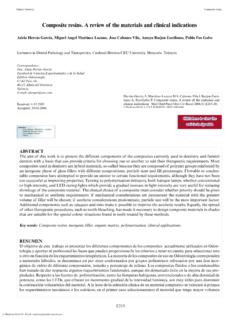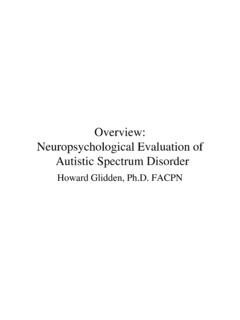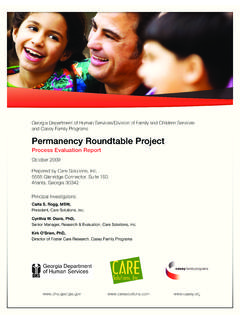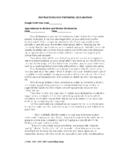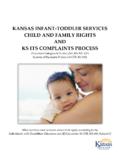Transcription of Orofacial features of Treacher Collins syndrome
1 E344 Med Oral Patol Oral Cir Bucal. 2009 Jul 1;14 (7):E344-8. Treacher Collins syndrome Journal section: Special patientsPublication Types: Case ReportOrofacial features of Treacher Collins syndromeHerc lio Martelli-Junior 1, Ricardo D. Coletta 1, Roseli-Teixeira Miranda 2, Let zia-Monteiro de Barros 2, M rio-S rgio Swerts 2, Paulo-Rog rio Bonan 31 Department of Oral Diagnosis, Dental School, State University of Campinas, Piracicaba, S o Paulo, Brazil 2 Department of Oral Diagnosis, Dental School, University of Alfenas, Alfenas, Minas Gerais, Brazil3 Stomatology Clinic, Dental School, State University of Montes Claros, Montes Claros, Minas Gerais, BrazilCorrespondence: Stomatology Clinic, Dental School State University of Montes Claros Montes Claros, Minas Gerais, Brazil 15/09/2008 Accepted: 24/01/2009 Martelli-Junior H, Coletta RD, Miranda RT, Barros LM, Swerts MS, Bonan PR.
2 Orofacial features of Treacher Collins syndrome . Med Oral Patol Oral Cir Bucal. 2009 Jul 1;14 (7):E344-8. Collins syndrome (TCS) is a rare autosomal dominant disorder of craniofacial development. Major fea-tures include midface hypoplasia, micrognathia, microtia, conductive hearing loss, and cleft palate. The present study is on the Orofacial features of 7 Brazilian patients with sporadic TCS aged 4 to 38 years. All patients pre-sented the typical down-slanting palpebral fissures, colobomas, zygomatic and mandibular hypoplasia, partial absence of the lower eyelid cilia, and abnormalities of the ears. Malocclusion was present in all patients, and an anterior open bite was found in 3 patients. None of the patients had a cleft words: Treacher Collins syndrome , Orofacial features , genetic Number: 5123658897 Medicina Oral S. L. B 96689336 - pISSN 1698-4447 - eISSN: 1698-6946eMail: Indexed in: -SCI EXPANDED-JOURNAL CITATION REPORTS-Index Medicus / MEDLINE / PubMed -EMBASE, Excerpta Medica-SCOPUS-Indice M dico Espa ol IntroductionTreacher Collins syndrome (TCS) or mandibulofacial dysostosis (OMIM 154500) is an autosomal dominant disorder with high penetrance and variable expressiv-ity (1).
3 The essential features of this syndrome were de-scribed by Treacher Collins in the year 1900 (2), but the first extensive description of the condition was produced by Franceschetti and Klein in 1949, who used the term mandibulofacial dysostosis (1). The frequency of TCS is 1 in 50,000 live births (2), and approximately 60% of the autosomal dominant occurrences arise as de novo mutation (3). Genetically, the treacle gene (TCOF1) is mutated. It is found on chromosome and en-codes a serine/alanine rich nucleolar phosphoprotein responsible for the craniofacial development (4). Other modes of inheritance such as autosomal recessive trans-mission and a role for gonadal mosaicism and chromo-somal rearrangement in the causation of this syndrome have also been proposed (5).TCS is characterized by downward slanting palpebral fissures and hypoplasia of the zygomatic arches (6).
4 Other craniofacial alterations of the syndrome are man-dibular hypoplasia, coloboma, total or partial absence of lower eyelashes, accessory skin tags or blind pits be-tween the tragus and the mandibular angle, external ear malformations, hearing loss, and malformations of the heart, kidneys, vertebral column and extremities. The oral manifestations are characterized by cleft palate, shortened soft palate, malocclusion, anterior open bite, and enamel hypoplasia (7). The aim of this study is to describe the Orofacial features of 7 patients affected by Oral Patol Oral Cir Bucal. 2009 Jul 1;14 (7):E344-8. Treacher Collins syndrome Case ReportsWe selected a sample of 7 cases from the Stomatolo-gy Clinic, Dental School, State University of Montes Claros, and from the Department of Oral Diagnosis, Dental School, University of Alfenas from 2002 to 2006.
5 Minimal criteria for propositi to be included in the casuistic were the presence of hypoplasia of the zygo-matic arches and downward slanting palpebral fissures (6). The protocol for evaluation of the patients included identification data; prenatal, perinatal, and family his-tory. Clinical evaluation included general examination with particular concern to oralfacial features . Skull and facial X-rays and hematological exams were also per-formed. Informed consent was taken from the patients or from the legal guardians of the children. This study was approved by Ethics Committee of Dental School, University of Alfenas. Six patients were females and 1 was male, and the mean age was years (range from 4 to 38 years). The mean maternal age was years, and the mean paternal age was years. There was no history of exposure neither to known teratogenic agents nor maternal diseases.
6 In any pregnancy and case peri-natal complications were related. All cases were isolat-ed with negative family history for related features . No parental consanguinity was observed. Hematological studies were normal in all patients. All patients demon-strated an age-appropriate mental and speech main Orofacial findings of the presented cases are listed in (Table 1) ( ) show pictures of the rep-resentative abnormalities found in the patients of this study. All patients showed downward slating palpebral fissures, zygomatic (malar) hypoplasia, lower eyelid coloboma, partial absence of the eyelashes, lower im-plantation and deformities of the external ear, and man-dibular hypoplasia. In relation to external ear anomalies, 4 out of 7 ears presented microtia. Absence of commu-nication between internal and external accoustic mea-tus leading to hearing loss was detected in 4 ( ) out of 7 patients, extension of the hair-line onto the cheek (facial implantation of the hair) was presented in 6 ( ), and narrowed frontal bone was detected in 5 ( ).
7 In relation to intraoral anomalies, all patients demonstrated malocclusion, 3 out of 7 presented open bite, and 1 patient showed shortened of the soft palate. Cleft palate was not observed in any findingsCase 1 Case 2 Case 3 Case 4 Case 5 Case 6 Case 7 Downward slanting palpebral fissures+++++++Coloboma+++++++Partial absence of eyelashes+++++++Zygomatic (malar) hypoplasia+++++++Retrusive mandible+++++++Lower implantation of the external ear+++++++External ear deformity+++++++Absence of communication between internal and external acoustic meatus++--++-Narrowed palate++++--+Anterior open bite+++----Shortened soft palate+------Facial implantation of the hair++++-++Narrowed frontal bone++++-+-Table 1. The main clinical Orofacial findings of our cases.(+) presence, and (-) 1. Frontal facial aspects clinical of the patients 3 and 7. These pictures are showing the antimongoloid slants of the palpebral fis-sures, mandibular and zygomatic hypoplasia, coloboma of the lower lid, and absence of lower eyelid cilia.
8 E346 Med Oral Patol Oral Cir Bucal. 2009 Jul 1;14 (7):E344-8. Treacher Collins syndrome Fig. 3. This figure is showing the patient number 2 with audiological rehabilitation. This picture is also show-ing the patient 7 after the facial plastic 2. Clinical features of deformities of the ear often leading to conductive hearing loss (patients 1, 3 and 4). The intraoral exam showed ac-centuated anterior open bite with malocclusion (patients 1 and 3).E347 Med Oral Patol Oral Cir Bucal. 2009 Jul 1;14 (7):E344-8. Treacher Collins syndrome Discussion TCS has been well documented as an autosomal domi-nant genetic disorder (1).
9 The pleiotropic effects of au-tosomal dominant mutant genes have been observed in a large number of craniofacial syndromes, such as Ap-ert syndrome (craniosynostosis, maxillary hipoplasia, syndactyly-symphalangism, acne, brachymelia), velo-cardio-facial syndrome (platybasia, cleft palate, heart anomalies, learning disabilities, ocular anomalies) and Robinow syndrome (hypertelorism, platybasia, bra-chymelia, and short phallus to name a few). In these syndromes, as in the majority of craniofacial multiple anomaly syndromes, there are both craniofacial and ex-tracranial anomalies (8).TCS is a well-recognized condition characterized by variable involvement of the craniofacial structures de-rived from the first and second branchial arches (1). Clinically, it ranges from hypoplasia of the zygomatic arches and antimongoloid slant of the palpebral fissures, which are considered the minimal diagnostic features , to a more complex phenotype with skeletal, cardiac, and renal manifestations (8).
10 The pathogenetic mechanisms involved have been controversial and no definitive caus-al agent could be found so far. It has been postulated that the TCS represents a defect of blastogenesis that could be attributed to interferences in cephalic neural crest cell histodifferentiation (1); however, the multi-systemic involvement in some cases does not sustain only a localized et al. (2004) (6) defined the downward slanting palpebral fissures and the hypoplasia of the zygomatic archs as the minimal features for the diagnosis of TCS. In this series, besides those minimal diagnostic fea-tures, the main signs found in all affected patients were mandibular hypoplasia, lower eyelid coloboma, partial absence of the eyelashes, and deformities and lower im-plantation of the ears. The absence of communication between the internal and external acoustic meatus lead-ing to hearing impairment was only found in patients with microtia, suggesting that microtia in TCS is related to inner ear defects.
